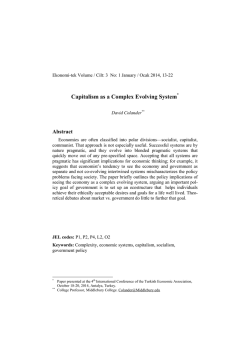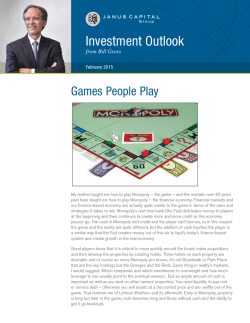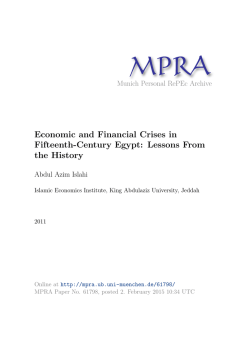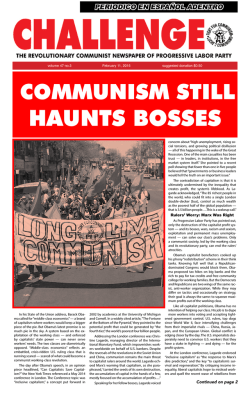
Composition in the 21st Century: The Need for Critical Insertion
Pàmies 1! of 27 ! Composition in the 21st Century: The Need for Critical Insertion Joan Arnau Pàmies doctoral candidate in composition at Northwestern University (Evanston, Illinois) I. Attempting to prescribe what the role of the Western composer in the early 21st Century should be may be perceived as a lost cause. Some may even say that doing so would be an act of totalitarianism; that I would be interfering with individual, artistic liberty—that there is no single role, but many potential roles. Ideally, composers and artists should always have the absolutest of freedoms to make any work they want without anyone or anything coercing them into oppressive aesthetic, political, or socioeconomic structures. One should start this critique from here. I am not trying to oblige anyone to make and organize sounds according to certain traditions. I am not declaring that some aesthetic approaches inherently have greater legitimacy than others. If we all were making music in a vacuum, where nothing besides that music could influence the works we created, any music could exist notwithstanding outer prominent forces. However, we composers do not live in a vacuum. Instead, we are part of a brutal economic system of production and distribution whose impact can be recognized beyond the realm of economics. As Karl Marx wrote in 1859, “[i]n the social production of their existence, men [and women] inevitably enter into definite relations, which are independent of their will, namely relations of production appropriate to a given stage in the development of their material forces of production. The totality of these relations of production constitutes the economic structure of society, the real Pàmies 2! of 27 ! foundation, on which arises a legal and political superstructure and to which correspond definite forms of social consciousness. The mode of production of material life conditions the general process of social, political and intellectual life. It is not the consciousness of men [and women] that determines their existence, but their social existence that determines their consciousness.”1 This paragraph is central to Marx’s historical materialism. In fact, historical materialism has permeated the left’s intellectual ecosystem, and its implications have been studied by a number of thinkers for a long time: Trotsky, Lenin, Pankhurst, Adorno, Luxemburg, Benjamin, Althusser, Horkheimer, Arendt, Jameson, Marcuse, Harvey, Negri, Foster, Žižek… these are just a few names; many more could be added to this list. This essay makes a simple, straightforward argument based on Marx’s analysis of historical materialism: composers do not live in the aforementioned vacuum where anything could potentially happen without further consequences beyond the domain of music; instead, it must be our responsibility to make music that challenges the capitalist status quo. Before I delve into what this “new music” may be, it is imperative to dismantle certain assumptions that have been made about modernism. Often, these are made through the lens of postmodernity: Lyotardian micronarratives2 are seemingly more efficient at giving a voice to those who had never had access to independent discourse. Postmodernism aligns itself with the liberation of socalled minorities; it primarily touches upon feminism, gender and LGBT rights, and race. It goes without saying that these are indeed exceedingly critical issues that need to be examined and rectified. However, it seems to me that among a number of so-called liberal thinkers who adopt 1 “Karl Marx: A Contribution to the Critique of Political Economy,” accessed April 26, 2015, https:// www.marxists.org/archive/marx/works/1859/critique-pol-economy/. Emphasis added. 2 Jean-François Lyotard, The Postmodern Condition: A Report on Knowledge (Minneapolis: University of Minnesota Press, 1984). Originally published in 1979. Pàmies 3! of 27 ! the discourse of identity politics, there tends to be a common disregard for an equally important expression that should be part of the overall equation as well; that is, class struggle. Adorno and Horkheimer never sacrificed their greater critique of the underpinnings of capitalism in order to defend the rights of so-called minorities, yet they still pointed to aspects that are commonly associated with identity politics. A passage of their Dialectic of Enlightenment is revelatory with regard to sexual oppression against women: “Man as ruler refuses to do woman the honor of individualizing her. Socially, the individual woman is an example of the species, a representative of her sex, and thus, wholly encompassed by male logic, she stands for nature, the substrate of never-ending subsumption on the plane of ideas and of never-ending subjection on that of reality. Woman as an allegedly natural being is a product of history, which denatures her. But the desperate, destructive urge directed against everything which embodies the lure of nature, everything which is physiologically, biologically, nationally, or socially inferior, indicates that Christianity’s attempt has failed.”3 One must have both: identity and class. In relation to pseudoprogressive identity politics, Sharon Smith argues that “it is not necessary to personally experience a form of oppression to become committed to opposing it. Yet the central premise of the theory of identity politics is based on precisely the opposite conclusion: Only those who actually experience a particular form of oppression are capable of fighting against it. Everyone else is considered to be part of the problem and cannot become part of the solution by joining the fight against oppression. The underlying assumption is that all men benefit from women’s oppression, all straight people benefit from the oppression of the LGBT community, and all 3 Theodor W. Adorno and Max Horkheimer, Dialectic of Enlightenment (Stanford, California: Stanford University Press, 2002), 87. Pàmies 4! of 27 ! whites benefit from racism.”4 Smith further adds: “The theory of identity politics locates the root of oppression not with a capitalist power structure but with a ‘white male power structure.’ The existence of a white male power structure seems like basic common sense since, with rare exceptions, white men hold the reigns of the biggest corporations and the highest government posts.”5 While it is unquestionably true that generally white men have been running the world up to this day, one should not make the assumption that the enemy is white maleness. One needs to remember Condolezza Rice, Colin Powell, Hillary Clinton, Herman Cain, Tim Scott, Sarah Palin, Michele Bachmann, Marco Rubio, Ted Cruz, Margaret Thatcher, Phyllis Schlafly, and what could be a longer list of members of so-called minorities that have, at some point or another, enforced (or clearly tried to) repressive policies equivocally associated with white maleness only. To conclude that having someone who is not a white man in a position of power is intrinsically a good thing is misleading. It surely demonstrates that white maleness is losing hegemony in the higher socioeconomic strata of society (and this is a reason to be satisfied), but it is not a strong enough motive to suppress the necessary, larger critique of capitalism. The core of the problem is the higher socioeconomic strata. This is the main issue I see in Georgina Born’s Rationalizing Culture.6 While her ethnographic study of IRCAM does provide good insight into the lack of women and non-white people within the Parisian institution in 1984, it completely neglects to ask whether this unfortunate situation might have been related to the greater logic of contemporary society. 4 “Sharon Smith: The Politics of Identity,” International Socialist Review, accessed April 26, 2015, http:// www.isreview.org/issues/57/feat-identity.shtml. 5 6 Ibid. Georgina Born, Rationalizing Culture: IRCAM, Boulez, and the Institutionalization of the Musical Avant-Garde (Berkeley and Los Angeles: University of California Press, 1995). Pàmies 5! of 27 ! Instead, Born claims that 1984 IRCAM had racial and gender biases due to the predominant modernist ideology that, so she says, was representative of the institution. In another article written by Born called “On Musical Mediation,”7 the author also glorifies jazz and popular music, for, according to her, jazz is inherently “lateral and processual,”8 as opposed to being “hierarchical” and object-centered; qualities that Born associates with modern music.9 By looking into both texts, I will attempt to question her reductionistic arguments against modernism as a means to put an end to the assumption that modern and avant-garde music is intrinsically despotic. On the other hand, another text I will look into is Sianne Ngai’s Our Aesthetic Categories.10 Ngai develops an aesthetic theory that makes an effort to explain how the hypercommodification of contemporary capitalism has influenced art and mass culture. Her assertion is that one can pinpoint three main aesthetic categories—the zany, the cute, and the interesting—that have emerged as byproducts of capitalism in the late 20th and early 21st Centuries. I will argue that Ngai’s categories may certainly provide a more appropriate theoretical framework for aesthetics than earlier paradigms, but that such a framework cannot be taken, at least a priori, from a prescriptive perspective (i.e., what artists should do), for that would lead to the reiteration of the same models that need to be questioned. 7 Georgina Born, “On Musical Mediation: Ontology, Technology, and Creativity.” twentieth-century music 2, 1 (2005), 7-36. 8 Ibid., 27. 9 Ibid., 27. 10 Sianne Ngai, Our Aesthetic Categories: Zany, Cute, Interesting (Cambridge, MA: Harvard University Press, 2012). Pàmies 6! of 27 ! Finally, my conclusion will provide the prelude to an argument—which will require collective magnification to fully blossom—in order to develop a common artistic ground among those of us who believe in the power of music to filter into society’s greater psyche and (hopefully) contribute to the much needed change of those socioeconomic and cultural structures that oppress us. II. Georgina Born’s Rationalizing Culture is a polemical text. Beyond the primary purpose of the book,11 Born develops a discourse on what seems to be her severe antipathy for the avantgarde phenomenon. It is quite fascinating to read how the author conceals her agenda by ideologically aligning herself with the pseudo-progressive discourse of superficial readings of identity politics, thus neglecting to engage with the greater, threatening logic of contemporary capitalism. Among the authors Born likes to cite, one can find Pierre Bourdieu and Raymond Williams. She expresses that “[b]oth writers begin by acknowledging the sociological specificity of art and culture. Unlike the majority of scholars working in cultural studies over the past two decades, both are committed to analyzing the cultural field as a totality, to tracking the way that any cultural form must be grasped through its implicit differentiation from coexistent forms.”12 One should remember that Born approaches her research from the perspective of social anthropology, not musicology—this will lead her to fabricate grave assumptions in terms of her 11 The opening line of Born’s research document states the following: “This book centers on an ethnographic study of IRCAM (Institute de Recherche et de Coordination Acoustique/Musique).” (Born, Rationalizing Culture, 1.). 12 Ibid., 25. Pàmies 7! of 27 ! research and conclusions, as I will point out later. Born often goes back to the Bourdieuan distinction between cultural and economic capital as a means to question the raison d’être of the avant-garde. For her, avant-garde artists “saw themselves as a vanguard charged with pursuing uncompromising progress, by definition ahead of current tastes, and so with a pedagogic mission to educate and convert the unenlightened audience.”13 This is a crucial (and problematic) aspect in Born’s critique of the avant-garde: the alleged disconnect between the artistic artifact and contemporary audiences due to the unintelligibility of the work. By borrowing Francis Haskell and Renato Poggioli’s discourse, Born claims that avant-garde artists went through a “gradual internalization of an ideology which proposed that art must attempt to subvert the (aesthetic) status quo, since artistic value depends on being ‘ahead’ of current tastes, which implies that it must necessarily be incomprehensible to the present audience.”14 Furthermore, she even writes that “the majority of modernist movements centered on formal experiments designed to subvert and shock the avant-garde’s dual enemies: the academic and official art establishment and the bourgeois audience. They sought no broader social engagement or political effect.”15 Born’s reading of the avant-garde is tendentious and unfair. I would like to stress that the avant-garde—or, for that matter, any aesthetic project—cannot be categorized in such a simplistic manner. Perhaps it is true that Duchamp’s Fountain is an instance of art as subversion, but claiming that “the majority of modernist movements” had similar intentions is an overgeneralization. On the contrary, the avant-garde is a highly complex phenomenon that encompasses a wide variety of artists with differing goals. To claim that avant-garde artists 13 Ibid., 43. 14 Ibid., 43-44. Emphasis added. 15 Ibid., 42. Pàmies 8! of 27 ! “sought no broader social engagement” demonstrates that Born is unaware of the true nature of certain crucial aesthetic-political approaches, particularly in the domain of music. Frederic Rzewski, an American composer and member of Musica Elettronica Viva,16 was undeniably interested in the political in his practice, as one can easily perceive from several of his pieces such as Les Moutons de Panurge (1974) or The People United Will Never Be Defeated! (1975). Although Cornelius Cardew rejected his own experimental music at a later stage of his life, he cofounded the Scratch Orchestra, an experimental ensemble where anyone—no matter what gender or race they associated with or what level of musical skills they had—was invited to join and perform. As Cardew writes, “[p]eople in the Scratch Orchestra also took the line of integrating with the workers and fighting alongside them, as opposed to standing on the sidelines and cheering them on, or taking a stand above them and lecturing them on what they should be doing.”17 Paul Griffiths ratifies Cardew’s views of the orchestra by pointing to the fact that “[l]ike a revolutionary cadre, the Scratch Orchestra was from the first to be alert to its own evolution, and almost inevitably that evolution led it from the modeling of egalitarian relationships in music to active political engagement.”18 To her credit, Born does mention both Rzewski and Cardew in Rationalizing Culture and acknowledges their political interest, but then she makes the bold claim that their practice should be labeled as postmodern19 because their music seemingly fits a number of categories that she takes for granted. Postmodern music, according to Born, has to do with “indeterminism, irrationalism, sociopoliticization” and is 16 Musica Elettronica Viva (MEV) is an ensemble of freely improvised music founded in Italy in the mid-1960s that still performs to this day. 17 Cornelius Cardew, Stockhausen Serves Imperialism (London: ubuclassics, 2004), 7. 18 Paul Griffiths, Modern Music and After (Oxford: Oxford University Press, 1995), 187. 19 Born, Rationalizing Culture, 56-61. Pàmies 9! of 27 ! “physical, performative” and “simple”.20 It is certainly difficult to see how Rzewski and Cardew’s respective oeuvres, which for the most part have such clearly defined goals in terms of both the musical and the political, can be called irrational or simple. Born’s understanding of serialism is equally problematic: “The serialist composers of the ‘50s tried in different ways to generalize serialism in order to produce a new, universal method of composition. Following their reading of Webern’s late technique, they extended serialism to the rationalist and determinist control not only of pitch but of all other parameters of composition: rhythm and duration, dynamics, and timbre. This became known as ‘total,’ ‘integrated’, or ‘generalized’ serialism.”21 According to the author, a major figure of the avant-garde who embraced total serialism was Pierre Boulez. Born points out that “[h]aving purged the technique of Schoenberg’s ‘mistakes,’ Boulez announced that serialism alone was the way forward to music. This laid the groundwork for what became the dominant ‘50s avant-garde development, total serialism, in which (…) the structuralist principles of serialism were extended to dimensions of music other than pitch.”22 This latter claim is false. As Richard Hermann writes, “the vast majority of modernist composers never embraced ‘total serialism’—the closest attempt in music to determinism—and even the few who briefly did try it (such as Boulez) rejected it immediately.”23 Only very few pieces written at that time employed a “totally” serialist method. In the specific case of Boulez, the early Structures I, written in 1952, represents his last attempt 20 Ibid., 63. 21 Ibid., 50-51. 22 Ibid., 81. 23 Richard Hermann, “Reflexive Postmodern Anthropology Meets Musical ‘Modernism’: Georgina Born’s Rationalizing Culture: IRCAM, Boulez, and the Institutionalization of the Musical Avant-Garde. Berkeley, California: University of California Press, 1995, 390 pp.” The Online Journal of the Society for Music Theory 3, 5 (1997), accessed April 24, 2015, http://www.mtosmt.org/issues/mto.97.3.5/mto.97.3.5.hermann.html. Pàmies 10 ! of 27 ! at composing music in which all parameters are serialized24 (other major pieces by the composer, such as Le marteau sans maître (1955) and Répons (1984), do not follow the aesthetic prescriptions of total serialism that Born discusses). Furthermore, Born’s inaccurate belief that total serialism dominated the compositional landscape during that time was refuted by Joseph N. Straus in his famous article “The Myth of Serial ‘Tyranny’ in the 1950s and 1960s,”25 a statistical study about the influence of serialism on several domains of production and distribution in the new music apparatus. Straus stresses that “whether one is inquiring about academic positions, performances, publications, recordings, prizes and awards, or attention in the press, serial composers were represented roughly 15 percent of the time, hardly a position of dominance. Between half and two-thirds of composers, throughout the period and in all corners of the musical marketplace, wrote in a relatively conservative idiom, with a style that maintained strong ties to traditional tonality. The other significant groups of composers worked either in a free atonal style or in a more experimental idiom.”26 The relationship that Born describes between modernism and mass or popular culture also hides factual information. Born discusses Adorno and declares that his dialectical process results in “an active antagonism toward and repudiation of mass culture.”27 What Born fails to look after is that Adorno’s critique of mass culture is unequivocally connected to the underpinnings of the capitalist apparatus. Adorno does not hate mass culture per se; he does have 24 G.W. Hopkins and Paul Griffiths, “Boulez, Pierre.” Grove Music Online. Oxford Music Online. Oxford University Press, accessed April 24, 2015, http://www.oxfordmusiconline.com.turing.library.northwestern.edu/subscriber/ article/grove/music/03708. 25 Joseph N. Straus, “The Myth of Serial ‘Tyranny’ in the 1950s and 1960s.” The Musical Quarterly 83, 3 (1999), 301-343. 26 Ibid., 302. 27 Born, Rationalizing Culture, 45. Pàmies 11 ! of 27 ! problems with the appropriation and industrial reproduction of popular artifacts due to the necessities of consumerism. As he stresses in Dialectic of Enlightenment, “[t]he culture industry has developed in conjunction with the predominance of the effect, the tangible performance, the technical detail, over the work, which once carried the idea and was liquidated with it. By emancipating itself, the detail had become refractory; from Romanticism to Expressionism it had rebelled as unbridled expression, as the agent of opposition, against organization. In music, the individual harmonic effect had obliterated awareness of the form as a whole; in painting the particular detail had obscured the overall composition; in the novel psychological penetration had blurred the architecture. Through totality, the culture industry is putting an end to all of that.”28 The term “culture industry” is what Born fails to fully grasp. Adorno speaks of culture industry, while Born disregards the word “industry” and decides to only focus on the word “culture”. It seems that Born cannot (or does not want to) acknowledge that what she calls mass culture is a product of capitalism and the needs of the market. Unless this relationship is problematized, speaking of popular culture as if it were representative of “the people” is a fabrication that conceals the actual truth: capitalism is not concerned with the liberation of minorities and the tolerance of alternative discourses; capitalism has a fetish for the accumulation of capital and will systematically keep destroying anything that interferes with its agenda.29 Born writes that “[m]odernist assertions of difference from mass culture are expressed (…) as simple ‘uninterest’ in that culture.”30 But, again, this is incorrect, even in the domain of 28 Adorno and Horkheimer, Dialectic of Enlightenment, 99. 29 For more information about this phenomenon, I recommend reading Naomi Klein, The Shock Doctrine: The Rise of Disaster Capitalism (New York: Picador, 2008). 30 Born, Rationalizing Culture, 45. Pàmies 12 ! of 27 ! music. As Hermann remarks, “[t]he sole opposition contained ‘Within a unity of difference to popular music,’ ‘nonreference, absolute difference, nonacknowledgment’ versus ‘reference, transformation’ [all terms employed by Born] is also fraught with problems. Mahler’s Symphonies and Debussy’s piano music employed quotations and parodies of folk and popular musics; Schoenberg and his students made arrangements of works by Johann Strauss, the ‘WaltzKing’; with his Ebony Concerto, Stravinsky fills a commission from swing/jazz band-leader Woody Herman; Schoenberg and Stravinsky were both involved with film music (unsatisfactorily to them as it turns out); and Schoenberg had wonderful things to say about the music of George Gershwin.”31 I would also add to this list Bartók’s use of Hungarian folk music in his compositions, Shostakovich’s film scores, and Charles Ives’s Holiday Symphony as well as his 114 songs. This is perhaps the biggest issue with Born’s critique of the avant-garde: she assumes a previously acquired,32 simplistic, binary logic of opposition between modernism and postmodernism—two terms that cannot easily be compartmentalized—as a means to defend her bias against anything that vaguely resembles high art, serialism, or any other type of artistic product that is, according to the author, deterministic, rationalistic, universalist, cerebral, complex, or linear and teleological.33 In his fierce review of Rationalizing Culture (cleverly entitled Born to Die), Ben Watson, a Marxist music writer, points to a tendency that successively 31 Hermann, “Reflexive Postmodern Anthropology.” 32 These are some of the sources Born uses in order to differentiate modernism from postmodernism: Diana Crane, The Transformation of the Avant-Garde (Chicago: University of Chicago Press, 1987); Frederic Jameson, “Postmodernism, or the cultural logic of late capitalism.” New Left Review 146 (1984), 53-92; and, Simon Frith and Howard Horne, Art into Pop (London: Methuen, 1987). 33 Born, Rationalizing Culture, 63. As for the author’s claim that modern music is “teleological,” one should simply remember Boulez’s Third Piano Sonata (1955-57) or Karlheinz Stockhausen’s Klavierstück XI (1957)–among other aleatoric pieces of that decade—in order to realize that this is another one of Born’s misconceptions. Pàmies 13 ! of 27 ! appears throughout the book: “Rationalizing Culture retails the familiar postmodern narrative: the bad European father underestimated the Yankee son, and modernist centralization (aka the ‘Communist Party’/the welfare state) lost out to low-tech, the Apple Mac and the Internet (aka market liberalism).”34 He further adds: “[Born] accuses avant-garde artists of refusing the general audience ‘gratification’, as if audiences are a ready-made constituency, and not created by specific economico-artistic vectors.”35 Indeed, Born’s arguments throughout the book make the false assumption that postmodernism represents a definitive step towards individual liberation, when in fact most postmodern thinkers either avoid or neglect the critique of the greater socioeconomic logic.36 Similar issues also arise from Born’s “On Musical Mediation: Ontology, Technology and Creativity.”37 As she describes, “[music] favors associations or assemblages between musicians and instruments, composers and scores, listeners and sound systems—that is, between subjects and objects.”38 It is certainly relevant to discuss what the relationship is between these entities, but one cannot address the topic by vilifying modernism and the avant-garde. Moreover, it is infantile to make the assumption that popular music (and jazz, in the case of this particular article) inherently questions aspects of musical production such as ownership, agency, and hierarchy. Popular music and avant-garde music are not packages that have been already 34 Ben Watson, Adorno for Revolutionaries (London: Unkant Publishers, 2011), 119. 35 Ibid., 122. 36 Several philosophers have questioned the false progressiveness of postmodernism. Here is a number of relevant sources: Alex Callinicos, Against Postmodernism: A Marxist Critique (New York: Wiley, 1991); Alain Finkielkraut, The Defeat of the Mind (New York: Columbia University Press, 1995); and, David Harvey, The Condition of Postmodernity (Cambridge, MA: Blackwell, 1990). 37 Georgina Born, “On Musical Mediation: Ontology, Technology, and Creativity.” twentieth-century music 2, 1 (2005), 7-36. 38 Ibid., 7. Pàmies 14 ! of 27 ! determined by some sort of demiurge; these are approaches to music that are in constant processes of self-definition and cannot be separated from their socioeconomic context—cultures do not live within a vacuum. As Watson suggests in relation to Rationalizing Music (the same claim can be made about her article), “commitment to anthropological ‘science’ means Born’s book is devoid of any aesthetic judgements, apart from between-the-lines hints that everything at IRCAM is mandarin bullshit, and that her own involvement with pop is infinitely worthier; but this is moralistic pomp-populist point-scoring, not critique. (…) The treatment of Frank Zappa exemplifies anthropology’s squeamishness about facing the musical object. Born says that Pierre Boulez conducting Zappa was ‘a moderation of Boulez’s rejection of popular music.’ This remark could only be made by someone who has not seen or heard ‘Dupree’s Paradise.’ If this is pop, then Tempo is Smash Hits.”39 He further adds that “[a]nyone who had actually listened to a modicum of Zappa’s music, though, would have found the linkage [between Boulez and Zappa] unexceptional: like Boulez, Zappa extends the tradition of Debussy, Stravinsky, and Varèse, stringing together sonic events achieved by innovative instrumentation in order to reward the attentive ear.”40 Born’s severe categorization of musical aesthetics leads to this type of problems: Zappa was certainly influenced by many of the works by popular artists, but it is equally true that a significant portion of his production gravitates towards music often associated with the avantgarde. The same issue takes place in the domain of jazz. According to Born, “[t]he ontology of the musical work [i.e., the notated score, the modernist product] envisions a hierarchical 39 Watson, Adorno for Revolutionaries, 118. 40 Ibid., 118. Pàmies 15 ! of 27 ! assemblage: the composer-hero stands over the interpreter, conductor over instrumentalist, interpreter over listener, just as the work ideal authorizes and supervises the score, which supervises performance, which supervises reception. (…) the work ontology disavows each of the three orders of social mediation set out at the start of this article41 through its belief in music’s transcendence of the social. The sociality of music-making, the embeddedness of the work in broader social relations of class, gender, race and nation, its dependence on patronage or market exchange; none are understood as immanent in the musical object; all are disavowed and denied.”42 In contrast, “the jazz assemblage (…) is lateral and processual. Jazz entertains no split between ideal musical object and mere instantiation, no hierarchy between composer as Creator and performer as interpreter of the Word.”43 This is another blatant, fallacious generalization that needs to be tackled. Firstly, it should be noted that there are many examples of composers influenced by modern traditions whose works are explicitly connected to the social. Mathias Spahlinger, a living composer who resides in Berlin, has been focused throughout his long career on questioning the validity and certain totalitarian tendencies related to concert hall culture. As the composer says, “I see the development of new music in a very particular context. I am convinced that the material development of new music is characterized by a higher degree of self-reflection than we find in older works of art.”44 This level of awareness can be discerned in pieces such as 41 “[1] music’s social and temporal mediation and its nature as a distributed object (…); [2] music’s mediations have taken a number of forms, cohering into what we might term assemblages (…); [3] this approach has value in highlighting shifts in the dominant historical forms of musical assemblage.” (Born, “On Musical Mediation,” 8.). 42 Ibid., 26-27. 43 Ibid., 27. 44 Mathias Spahlinger, “how it is,” there is no repetition: mathias spahlinger at 70 (Chicago: University of Chicago, 2015). Pàmies 16 ! of 27 ! Extension (1979-80) for violin and piano, in which the two instrumentalists start performing their parts conventionally (i.e., on stage) while later on are free to leave the stage and do any type of activity that is not commonly associated with a more traditional understanding of music performance; or Doppelt Bejaht (2009), “a series of etudes for improvising, spatially distributed orchestra without conductor.”45 But even if one looks into the music of a composer like Brian Ferneyhough, whose works may superficially appear to be difficult, complex, formalist, inaccessible, and non-questioning of the greater logic, a similar level of social awareness can be perceived. Time and Motion Study II (1973-76) introduces a cellist bombarded by a monumental amount of notational information, which requires her to struggle in order to read and interpret the score. On top of that, the cellist is in charge of two pedals. Each of the pedals controls the amplitude of two delay processes that record the sound of the instrument during performance. Both delay processes reproduce the recorded sounds at different times: 9 and 14 seconds respectively after recording. Furthermore, the cellist is also asked to sing, but her voice is processed via ring modulation. This intricate setup, paired with the extreme interpretive difficulty in the score, portrays the instrumentalist as an individual who has been trapped in this tortuously oppressive system; i.e., labor productivity and Taylorism, as the title of the piece evidently suggests. Other pieces by a variety of composers have also focused on the social: Luigi Nono’s Intolleranza 1960, Stockhausen’s Aus den sieben Tagen (1968), Christian Wolff’s Burdocks (1970-71), Johannes Kreidler’s Fremdarbeit (2009), Richard Barrett’s CONSTRUCTION (2005-2011), etcetera. Born’s belief in the separation between so-called modern music and the real world is thus inconsistent with the facts. 45 “3/12: Concert 3,” there is no repetition: mathias spahlinger at 70, accessed April 25, 2015, http:// norepetition.tumblr.com/march12. Pàmies 17 ! of 27 ! Secondly, it is problematic to take for granted that jazz, as an aesthetic, intrinsically questions certain traditional hierarchies. One can think of Muhal Richard Abrams and the AACM, the Art Ensemble of Chicago, Cecil Taylor, Ornette Coleman, or even John Coltrane. Indeed, these (jazz) musicians did attempt to explore alternative means of music-making. But jazz is also represented by Wynton Marsalis’s Lincoln Center series, Kenny G, Diana Krall, Paquito D’Rivera, St Germain, Jamie Cullum, and many other commercial artists who buy into the commodification of music—and neither do they address the present oppression of black Americans who live in poverty nor issues of gender or race.46 Strange fruit has faded into oblivion. Overall, Georgina Born’s discourse easily falls apart after comparing her assumptions to the foundations of modernity. III. Sianne Ngai’s Our Aesthetic Categories is a tour de force in the domain of aesthetic theory. Ngai’s purpose in writing the book is crystal clear from its very first paragraph: “This book makes a simple argument about the zany, the interesting, and the cute: that these three aesthetic categories, for all their marginality to aesthetic theory and to genealogies of postmodernism, are the ones in our current repertoire best suited for grasping how aesthetic experience has been transformed by the hypercommodified, information-saturated, performancedriven conditions of late capitalism.”47 The book is divided into five chapters: an extensive 46 The connection between poverty, race, and gender is crucial. No one in the official socioeconomic structures questions Condolezza Rice for being a black woman or Ted Cruz for being latino. 47 Ngai, Our Aesthetic Categories, 1. Pàmies 18 ! of 27 ! introduction that touches upon the significance of these three aesthetic categories as a means to address a culture that has been transformed into a product of consumerism, three chapters about each respective aesthetic category, and an afterward. Ngai’s allegiance to Marxist methodology can be recognized throughout the book, thus avoiding the traditional rhetoric of postmodernism that scholars such as Georgina Born employ. Ngai argues that “[t]he best explanation for why the zany, the interesting, and the cute are our most pervasive and significant categories is that they are about the increasingly intertwined ways in which late capitalist subjects labor, communicate, and consume. And since production, circulation, and consumption are not just economic processes but also modes of social organization, our experiences of the zany, the interesting, and the cute are always implicit confrontations with the imaginary publics that these ways of working, communicating, and consuming assume or help bring forth.”48 The author acknowledges that her categories are products of Western capitalism, as she writes that they emerge “in tandem with the development of markets and economic competition, the rise of civil society, and an increasingly specialized division of labor.”49 Furthermore, she adds that “[t]he rise of the weak or trivial aesthetic categories (…) thus takes place in conjunction with an overarching habitualization of aesthetic novelty, an increasing overlap between the domains of art and theory, and a loss of the longstanding tension between the work of art and the commodity form.”50 These are qualities often discussed by Adorno and Horkheimer in Dialectic of Enlightenment. Ngai’s analysis of the three aesthetic categories at stake is insightful and does provide an alternative way of looking at aesthetics beyond the Kantian understanding of beauty 48 Ngai, Our Aesthetic Categories, 238. 49 Ibid., 15. 50 Ibid., 21. Pàmies 19 ! of 27 ! that, according to Ngai, is still of major importance in the works of other philosophers such as Nietzsche, Adorno, Hegel, and Derrida.51 This is a consequence of Ngai’s own take on affect theory52: “Indeed, the zany, the interesting, and the cute seem to offer ways of negotiating these problems affectively, both at the formal, objective level of style (…) and at the discursive, subjective level of judgement.”53 She further adds that “[t]he zany, the cute, and the interesting thus help us imagine what the discourse of aesthetics might become when aesthetic experience is no longer automatically equated with awe, or with rare or conceptually unmediated experience.”54 Ngai thus advocates for a materialistic approach to the assimilation of aesthetic phenomena, which embodies a greater subjectification—through the bodily, the physical, and the psychological—of analytical methodologies. Nonetheless, Ngai attempts to approach the zany, the cute, and the interesting “as objective or formal styles”55 as well. Her categories are taken from both perspectives: judgement and style. According to Ngai, the “cute” aestheticizes powerlessness. Something is cute when it is weak, tiny, diminutive, or unthreatening. However, in certain cases, this only happens on a superficial level. A very insightful example of this is Robert Creeley’s poem “The Willys”,56 51 Ibid., 2. 52 Affect theory may be defined as a relatively recent approach to analysis via a greater understanding of both bodily and psychological processes. Lauren Berlant, Elspeth Probyn, and Brian Massumi are three of its representative authors. Massumi, in fact, was the translator of Deleuze and Guattari’s A Thousand Plateaus into English, a text that arguably has influenced the field of affect theory. 53 Ngai, Our Aesthetic Categories, 2. 54 Ibid., 24. 55 Ibid., 29. 56 Creeley’s poem: Little dollar bills. Pàmies 20 ! of 27 ! which Ngai uses to suggest that the cute has the ability to dramatize “even the money commodity —the most immediate embodiment of exchange value, according to Marx, or the commodity whose use resides precisely in its exchangeability—”57as a fetish. This is particularly interesting because, according to Ngai, cuteness is often embodied into soft, blob-like faces (such as frogshaped sponges,58 the emoji smiley face,59 or Murakami’s round-shaped character DOB60) that are seemingly guiltless, yet it is “capable of making surprisingly powerful demands.”61 One could thus argue that behind the surface of cute aesthetic products lies a byproduct of the cultural consequences of capitalist propaganda. Jennifer Lynde Barker defines Ngai’s “the interesting” “as an aesthetic category typified by the idiosyncratic, discursive, incomplete, and relativistic, as well as the ordinary, inessential, and accidental.”62 Ngai uses John Baldessari’s Choosing in order to demonstrate some stylistic qualities of the interesting. Baldessari’s example consists of a series of four photos. Each photo contains three green beans, and since the shape of the green beans is quite different from photo to photo, one eventually assumes that, in fact, there may be a total of twelve green beans. However, as Ngai explains, “[e]ach row shows a finger pointing to one green bean out of an array of three, then another as the nonchosen beans are replaced with two others, and so on.”63 The formal subtlety in the sequence of photos is thus evident. The author then claims that “[f]rom this 57 Ngai, Our Aesthetic Categories, 63. 58 Ibid., 64. 59 “Sianne Ngai: Visceral Abstractions,” Vimeo, accessed April 25, 2015, https://vimeo.com/101565050. 60 Ngai, Our Aesthetic Categories, 82. 61 Ibid., 64. 62 Jennifer Lynde Barker, “Our Aesthetic Categories: Zany, Cute Interesting by Sianne Ngai,” Film Quarterly 67, 1 (2013), 81. 63 Ngai, Our Aesthetic Categories, 33. Pàmies 21 ! of 27 ! perspective, the seemingly styleless style of Baldessari’s series, with its pun on connoisseurship by featuring acts of discerning fine difference between things of a particularly humble type, reads more like another metastyle: a style precisely about how there is ‘no question of style unless there is the possibility of choosing between alternate forms of expression,’ as Stephen Ullman puts it.”64 By stylistically becoming a phenomenon of “yet-to-be”65 conceptualization, Ngai relates the interesting’s objective features to its own ability “to highlight and extend the period of an ongoing conversation.”66 The interesting’s capacity “to differ (…) from a general expectation or norm whose exact concept may itself be missing at the moment of judgement”67 makes this aesthetic category highly unstable, in that it becomes “a placeholder for further judgment.”68 Consequentially, the interesting is an aesthetic in a constant process of self-redefining its own, deepest nature. Ngai’s final category, “the zany”, is perhaps the only category that explicitly relates to matters of cheap labor and poor working conditions—aspects that are very common in neoliberalism.69 Ngai explains that “the zany is about performing. Intensely affective and highly physical, it’s an aesthetic of nonstop action that bridges popular and avant-garde practice across a wide range of media: from the Dada cabaret of Hugo Ball to the sitcom of Lucille Ball.”70 The 64 Ibid., 34. 65 Ibid., 112. 66 Ibid., 234. 67 Ibid., 112. 68 Barker, “Our Aesthetic Categories,” 81. 69 For a better understanding of the neoliberal condition as a whole, I recommend David Harvey’s Brief History of Neoliberalism (Oxford: Oxford University Press, 2007), one of the most astute accounts of neoliberalism that I know of. 70 “Our Aesthetic Categories: An Interview with Sianne Ngai,” Cabinet Magazine, accessed April 25, 2015, http:// www.cabinetmagazine.org/issues/43/jasper_ngai.php. Pàmies 22 ! of 27 ! zany anthropomorphizes the strain of the working class into comedic characters that are confronted by an array of unfortunate circumstances. Ngai thus expresses that “this playful, hypercharismatic aesthetic is really an aesthetic about work—and about a precariousness created specifically by the capitalist organization of work.”71 Two of the examples she employs in order to demonstrate the influence of the zany are Ben Stiller’s 1996 film The Cable Guy and Richard Donner’s The Toy, starring Richard Pryor. In both movies, the main characters struggle at adapting to the system, as they get into different freaky situations. In The Toy, “Carl, the male African American protagonist, masquerades as a woman, Lucy, to get hired as a domestic servant for a wealthy white family.”72 In The Cable Guy, Jim Carrey’s character (i.e., the cable guy), after plugging Steven’s (his client) apartment into the cable network, “voluntarily provides [him] with the bonus service of social networking, devising complex machinations to keep Steven, recently jilted by his fiancée and extremely depressed, linked to his coworkers, friends, and family, and thus from sliding into an alienated and unproductive stupor in front of his television.”73 In consequence, the zany supplies a number of fictional characters that are incapable of doing their jobs properly, yet still try to do so in the most ridiculous, foolish ways. The zany, in my view, embodies the current lack of Marx’s concept of class consciousness in the minds of the oppressed workers. From a purely analytical point of view, Ngai’s categories surely contribute to getting better insight into aesthetic paradigms of contemporary capitalism. Nonetheless, they do not have any sort of prescriptive power if the artist wishes to create cultural artifacts that escape the 71 Ngai, Our Aesthetic Categories, 188. 72 Ibid., 210. 73 Ibid., 198. Emphasis added. Pàmies 23 ! of 27 ! necessities of the market, unless the artistic treatment of these categories dialectically clashes against ideas outside the immediate influence of the market (e.g., one may want to use the zany; the question is in which way it is used and whether certain recontextualizations of the category can still be considered to be Ngai’s definition of the zany; is the zany still zany when it is aware of its zaniness?). Mass culture and art may be zany, interesting, or cute as a result of the socioeconomic intricacies of Western capitalism and not the other way around. Adorno and Horkheimer present a narrative of the creation and distribution of culture within capitalism that arguably has not been surpassed yet: “the planning is in fact imposed on the industry by the inertia of a society irrational despite all its rationalization, and this calamitous tendency, in passing through the agencies of business, takes on the shrewd intentionality peculiar to them. For the consumer there is nothing left to classify, since the classification has already been preempted by the schematism of production.”74 The means of production define the nature of culture, so it is crucial to recognize who owns the means of production in order to find out what the owners’ ultimate reasons are behind the distribution of culture. Georgina Born’s unaddressed assumption that the market signifies freedom—as opposed to state-funded art, which according to Born results in the homogeneity of thought75 (i.e., IRCAM is a public institution that constrains composers by forcing them to succumb to modernism and its evil plan)—is misleading and sadly irresponsible, to the extent that it resembles some of the most reactionary and irrational Friedmanesque76 beliefs that one can encounter. Fortunately, Ngai, on the other hand, shows 74 Adorno and Horkheimer, Dialectic of Enlightenment, 98. 75 The whole chapter 4 (“The Institution of IRCAM: Culture and Status,” 102-142) in Rationalizing Culture is a rant that links the lack of female presence within the French institution to the ideological stand of modern music. 76 I suggest reading Milton Friedman, Capitalism and Freedom (Chicago: University of Chicago Press, 1962). Pàmies 24 ! of 27 ! greater awareness of the relationship between market and mass culture. I would even say that her three aesthetic categories converge into a fine theoretical basis that may enhance the necessity for an artistic-political attitude of resistance. IV. In conclusion, a question I often ask myself is, what is there to do under such hostile circumstances? What power do we have as composers to offer resistance and keep the struggle alive? It is excruciatingly difficult to find practical answers to these questions. Nonetheless, the alternative is the implicit cooperation with the status quo and the progressive loss of both individual and collective liberties. Evidently, this is not a desirable outcome. Answers will not come from individuals alone. As separate individuals, we can contribute with analyses, thoughts, and alternatives, but I highly doubt anyone will arrive at truly meaningful conclusions on their own. For that matter, a process of politicized collectivization of the aesthetic cause needs to take place. This is not to imply that aesthetic homogenization is desirable—not at all. Aesthetic hegemony often leads to dogma and rejection of any approach that strongly differs from such hegemony. Whether a composer writes pitches, timbres; parametric, text-based works; rhythmic, pulse-based music; mash-ups and respectful usage of other musics; tonally-oriented pieces; slow, long, or soft (not that these are qualities that should be placed together) music… None of this matters as much as one would think, since these are decisions based on what needs to be on the surface of a particular discourse. That is the reason Ngai’s theory of aesthetics may be extrapolated into the prescriptive domain, for it correlates every work of art with categories Pàmies 25 ! of 27 ! within the system—one thus has the opportunity to make music that avoids existent aesthetic categories and searches for new ones, confidently outside of capitalist cultural structures. A dialectical process within the logic of a particular piece and in relation to its outside world is what seems to me to be required. Among the horrors of certain postmodern trends, there is the belief that any artistic artifact—unless it spreads large amounts of explicit hate (i.e., fascism, homophobia, racism, etc.)—has the right to exist because, by not allowing its own raison d’être, one would become disrespectful and totalitarian. This view may be understandable, but nonetheless it conditions a cultural landscape that eventually becomes irresponsible and complacent of the greater state of affairs. By disengaging ourselves from dialectical critique and culturally authorizing quasi-anything, we play a part in the predominant free-for-all ideology that, under the disguise of progressiveness, hides its true endeavor; that is, the submission of humanity to pyramidal, cruel structures of power. Making, creating music is a tremendously laborious task, for music is formed by a complex system of signifiers on all of its levels. I firmly believe that it is one of the purposes of the composer to gain as much awareness of all the elements that contribute to a piece of music—this may seem obvious to some, but it certainly does not apply to most music that exists. However, the crucial remark that needs to be done with regard to this awareness involves the necessity for the emergence of an ultimate purpose that transcends inner musical boundaries. Awareness on its own is, yet again, the mere result of a culture that seemingly glorifies the heterogenous to the detriment of class struggle. This is a false truth that embodies the fallacious argument that class struggle is not in vogue anymore; it stands for the often heard assumption that the right and the left are not representative of the aforementioned heterogeneity of contemporary society—which, in turn, has been Pàmies 26 ! of 27 ! promoted by capitalism through its mechanisms of mass distribution. This fallacy is embedded in the Deleuzian rhizome,77 where anything may be related to everything anytime. Deleuze and Guattari surely presented a reasonable analysis of the propagandistic apparatus of contemporary capitalism, but it is critical that one gains consciousness of the descriptive character of their investigation—otherwise, a prescriptive reading of their work may lead to reactionary results. In reality, socioeconomic classes are strictly compartmentalized and the natural abilities of the subject are not powerful enough to liberate itself from the constraints applied by class structures. The rhizomatic model does not work when one is in search for practical answers. In other words, a member of the working class cannot simply move back and forth between different socioeconomic strata due to her lack of monetary affluence. On the contrary, the capitalist, with her accumulation of capital, is free to roam around the many dimensions of reality. For this reason, the excessive permissibility of the postmodern condition towards aesthetics is unwelcome and needs to be replaced by a critical engagement of the work with regard to its position as a force of rebellion. The underlying connection between these “new musics” is not the superficiality of certain compositional methods, but rather their systematic intent to belong to a world outside capitalism—these musics must become a token of (so far) utopian realities.78 When Schoenberg questioned tonality by writing his early free pantonal pieces, he did an act of rebellion. The medium (tonality) that no one in the West ever challenged before—on a deep, conceptual level—was then rejected. For Mozart, Beethoven, and Brahms, music could not be conceived without tonality. Music was tonality. After Schoenberg’s post-tonal oeuvre, music did 77 Gilles Deleuze and Félix Guattari, A Thousand Plateaus (Minneapolis: University of Minnesota Press, 1987). Originally published in 1980. 78 About tokens of other realities, see “Richard Barrett: The Possibility of Music,” accessed April 26, 2015, http:// www.rogerreynolds.com/futureofmusic/barrett.html. Pàmies 27 ! of 27 ! not need tonality anymore to justify its own existence. When Lou Reed released Metal Machine Music in 1975, he brought Luigi Russolo’s ideas about noise and music back to the cultural forefront. Both Reed and Russolo questioned the traditional notion of music as organized sound. These were also acts of rebellion. The composer must insert herself into reality, not as a means to accept it, but to change it for the benefit of the collective. As Hannah Arendt affirms, “With word and deed we insert ourselves into the human world, and this insertion is like a second birth, in which we confirm and take upon ourselves the naked fact of our original physical appearance. This insertion is not forced upon us by necessity, like labor, and it is not prompted by utility, like work. (…) its impulse springs from the beginning which came into the world when we were born and to which we respond by beginning something new on our own initiative.”79 Insertion means taking individual action through collective effort, so that serious and critical engagement with the music that we make and surrounds us can be developed. To insert ourselves into the world; that is the role of composers in the 21st Century. 79 Hannah Arendt, The Human Condition (Chicago: University of Chicago Press, 1958), 176-177.
© Copyright 2025








